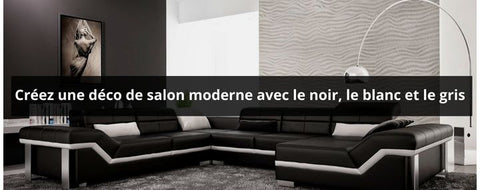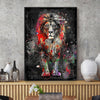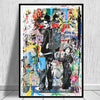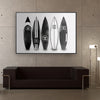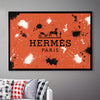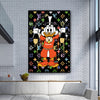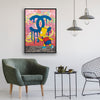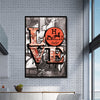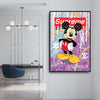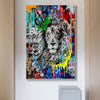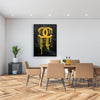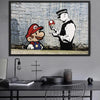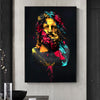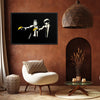
Industrial Style: Tips and Inspiration
In recent years, industrial design has become increasingly popular, and it's easy to see why. This decorating trend , which originated in the working-class world of the early 20th century, is one of the most fashionable design movements of the moment. Industrial-style decor blends modernity with old-world charm through an organic and vibrant atmosphere, creating a perfect interplay of contrasts.

But what does industrial style decoration really mean? And when it comes to designing industrial style homes, how can you make the look suit you without it becoming a taboo subject?
When we think of industrial style , we tend to associate it with a loft featuring large metal-framed windows, exposed brick, and beams. However, this design style isn't only applicable to urban environments.

As part of our series on design styles, which breaks down each movement using handy reference guides, we turned to interior designers for insights on mastering the industrial style concept with everything you need to know.
I) What is the industrial style?
The industrial style refers to a no-frills decor inspired by the stark appearance of warehouses, factories, and other industrial structures. Industrial-style decor includes stripped-down architectural details, such as the use of exposed brick, metal, and wood, as well as reclaimed and recycled materials.

Industrial-style furniture is generally durable and often sourced from salvage yards or specialty shops. The biggest advantage of creating an industrial-style home is the opportunity to personalize the look using furniture and décor that are completely unique to your space.
When planning an industrial-style living room, keep comfort in mind, even if everything is decorated in a minimalist style. Opt for simply designed furniture with sturdy, durable upholstery, natural textures, and neutral colors.
II) Why will you like industrial style interior decoration?
Industrial interior design is pleasantly flexible. Consisting mainly of neutral tones and materials that favor unique textures, this design style is easy to achieve with lighting, decor, and furniture.

Despite its simplicity and minimalist design, the industrial style manages to create a clean and modern atmosphere. It's an eco-friendly approach to interior design, as it encourages the use of recycled or reclaimed materials. There's no need for superficial embellishments when aiming for an industrial interior, as the emphasis is on using natural, unadorned finishes and materials.

III) How did the industrial style begin?
Although little is known about the origins of industrial-style interiors , it is widely accepted that this style developed in the early 20th century. At the end of the Second Industrial Revolution , the trend toward globalization became more pronounced. Dozens of factories closed and relocated their operations to other countries, and as a result, vacant industrial buildings fell into disrepair. This left behind an inexhaustible source of high-quality materials, which designers were quick to utilize.
IV) What are the main characteristics of the industrial style?
How to achieve an industrial style for your home? When it comes to designing industrial-style homes, consider these characteristics to ensure you achieve a flawless style.

A) The materials
Industrial spaces are all about mixing the old and the new. One of the simplest ways to highlight this contrast is to juxtapose different types of wood and metal in your interior.
When buying wooden pieces, there's a certain aspect you'll want to look for. Instead of searching for brand-new, completely finished items, focus on finding furniture that seems to have a story.

When it comes to metal, you have a wide range of options. The finish you choose will play a crucial role in your overall aesthetic. If you want the room to have a more vintage look, opt for a brushed or oiled finish. On the other hand, if you want the space to have a very trendy feel, choose polished chrome. Furthermore, remember that metal isn't just for lighting fixtures. In this case, it can be used for everything from shelves to kitchen bar stools.
B) Colors
One of the first things you'll notice about industrial spaces is the lack of vibrant color pops. This style relies instead on using a combination of neutral shades to create a clean, minimalist look. When designing an industrial-style living room, stick to neutral palettes of gray, black, and white.

Add whimsical layers with touches of darker tones. Bring personality and the unexpected with vibrant art that contrasts with your otherwise masculine, industrial-style decor. Unlike the darkness of more traditionally modern spaces, industrial interiors tend to be warmer and more inviting.
C) The silhouettes
The forms used in industrial interior design consist primarily of square lines and blocky shapes that promote a utilitarian cohesion in the overall look of your home. This doesn't mean you should completely avoid curves and abstract volumes; however, limiting them will help you achieve that sought-after industrial aesthetic .

Accessories – limit the use of accessories in an industrial-style home. Favor functional elements in a minimalist spirit . To decorate your bedroom in an industrial style, be sure to declutter and keep the space uncluttered. Use accessories such as large abstract artworks, metal structures, and other interesting reclaimed objects.
V) Tips for an industrial-style house
Other tips for easily giving your room an industrial style, shared by our interior design experts:
A) Start with a neutral color palette
One of the things you'll notice in industrial-style homes is that bold colors are reserved for small details, while the majority of the spaces radiate neutral tones. The style relies primarily on neutral color combinations to create a harmonious, clean, and minimalist look. For an industrial-style bathroom, exposed brick and white tiles are an essential combination, complemented by black glass elements with metal frames.

B) Industrial style wall decor: the rules
Don't hesitate to hang industrial-style wall art on your walls. It will add a sophisticated touch to the room while maintaining a harmonious look. Discover our best selection of paintings for industrial decor now.
C) Opt for an open space
Industrial-style homes are generally spacious and work well with an open floor plan. To prevent the space from feeling too large and difficult to decorate, strategically arrange industrial-style furniture in groups to divide the area. A great decorating idea for an industrial-style living room!
D) Combine wood and metal for an industrial look
It's easy to mix old and new materials. The best way to achieve this contrast is to combine different types of metal and wood in your overall design. For example, you could have a vintage wooden vanity and a steel-framed mirror in an industrial-style bathroom.

E) Lighting & Industrial Style
Lighting plays a central role in industrial decor ; most lamps should be made of metal, primarily metal pendant lights. When using pendant lights, they should be hung low with wide lampshades.
F) The ground
The floor can also be used to perfect your industrial decor. For this, we recommend opting for raw materials. To create harmony between metal furniture and the various decorations in the room, nothing beats polished concrete. Its neutral tone will blend perfectly with the interior while giving it a working-class feel . This basic element of industrial style, polished concrete, is an ultramodern and inexpensive option for your industrial decor.

There's no doubt why so many people have fallen in love with industrial design. It gives us the freedom to embrace antique beauty while enjoying modern conveniences. However, it's important to remember that this look isn't just for city dwellers. Use these tips as a guide, and you can recreate this aesthetic wherever you live.
See you soon.
The Lofty Trend Team.




